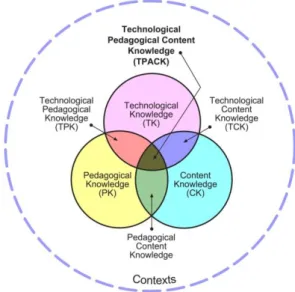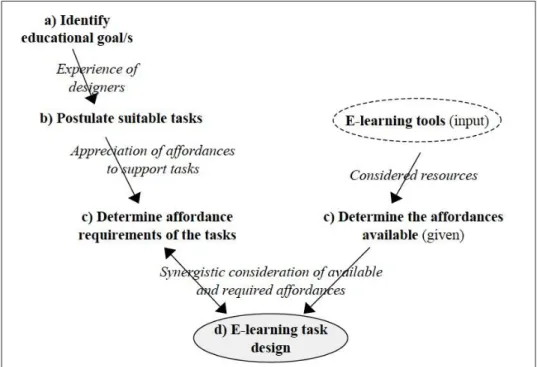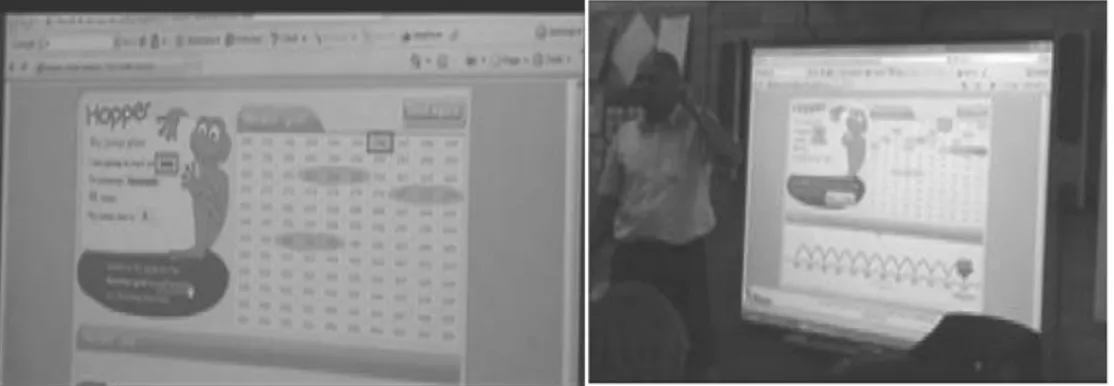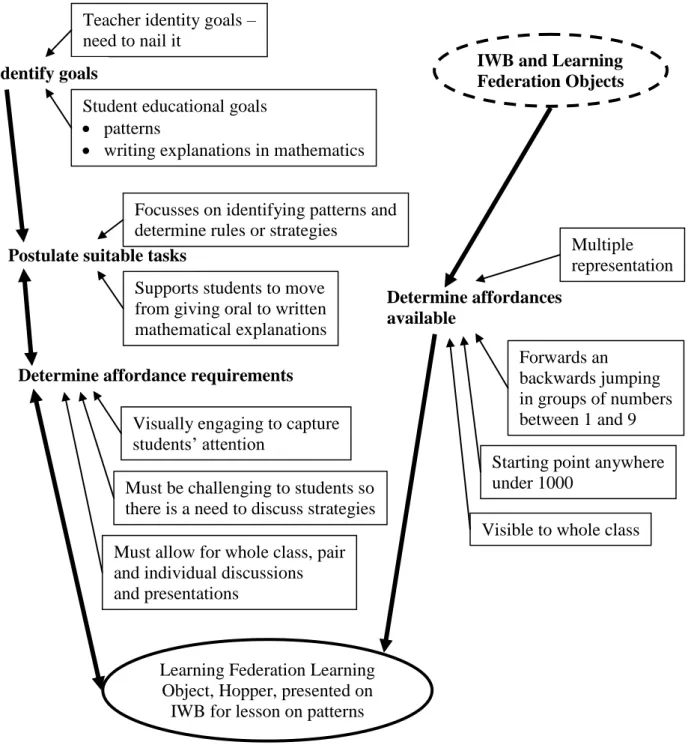DIGITAL TECHNOLOGIES AND DEVELOPING
MATHEMATICAL UNDERSTANDINGS
Troels Lange Tamsin Meaney Malmö University Malmö University
Teachers of mathematics have adopted willingly a variety of digital technologies. Yet for this to be done successfully, it has been suggested that teachers need to integrate knowledge of content, pedagogy and technologies (Mishra & Koehler, 2006). In this paper, one teacher’s story of planning and implementing a lesson on patterns using a digital resource on an Interactive White Board is analysed using Bower’s (2008) analysis of affordances of e-learning tools. We find that this captures better the dynamic decision making process of the teacher than Mishra and Koehler’s (2006) TPCK model of teachers’ knowledge. Nevertheless for this experienced teacher it was the mathematical and pedagogical considerations, which drove his desire to incorporate digital technologies in the lesson.
Keywords: Affordances, TPCK, digital technologies, number patterns
This paper explores one teacher‟s integration of a Learning Federation1
object,
Hopper (Curriculum Corporation, 2009), into a lesson on patterns. The teacher‟s
choice to use Hopper on the interactive whiteboard was partly influenced by the affordances it offered for supporting students to become better mathematical thinkers. Therefore, we critique models of teacher knowledge where the focus is on how teachers utilise (digital) technology. Instead we propose that this teacher‟s decision to use digital technologies came as a consequence of his understanding of the mathematical and pedagogical needs of his students. It is, therefore, more valuable to consider digital technologies as one resource that teachers can use if the affordances that they provide match the mathematical and pedagogical requirements of the lesson. Research into the use of digital technologies can be divided into that which investigates what teachers currently do and intervention studies designed to improve teachers‟ confidence in incorporating digital technologies into their teaching. Research on mathematics teachers‟ use of the internet suggests that predominantly it is used for planning with only limited use in learning activities designed for students (Moore-Russo, Viglietti, & Bateman, 2009). Research into the use of Interactive Whiteboards (IWBs) in mathematics education has concentrated on how teachers used the hardware. Miller, Glover, and Averis (2005) suggested that teachers gain the most effective pedagogical advantage from IWBs if they use a range of features. However, features, which are built in such as the touch screen and software options, only become valuable when integrated with internet resources such as the Learning
1
The Le@rning Federation manages the collection and infrastructure of digital curriculum resources that are aligned with the curriculums of the Australian states and territories. Adapted from
Federation objects. A pedagogical approach that advocates the use of a large number of features is limited as it does not allow for situations where few features may be better pedagogically. Furthermore, there has been criticism of the use of IWB because it has been shown to close down potentially enriching pedagogical approaches (Lerman & Zevenbergen, 2007). When the technology, digital or not, is more visible than the mathematics, then it is unlikely that the mathematical ideas remain the focus of the lesson (Adler, 2000).
Figure 1: Model showing the components of Mishra and Koehler’s (2006) Technological Pedagogical Content Knowledge (from: http://tpack.org)
In relationship to student teachers, a number of researchers found that graduating teachers felt unprepared and apprehensive about using ICT in their teaching (Lin, 2008). Holmes (2009) analysed how teachers and student teachers used the IWB with Mishra and Koehler‟s (2006) Technological Pedagogical Content Knowledge (TPCK) model (see Figure 1). TPCK was designed so that teacher educators could better facilitate student teachers‟ adoption of digital resources:
It attempts to capture some of the essential qualities of teacher knowledge required for technology integration in teaching, while addressing the complex, multifaceted, and situated nature of this knowledge. We argue, briefly, that thoughtful pedagogical uses of technology require the development of a complex, situated form of knowledge that we call Technological Pedagogical Content Knowledge (TPCK). In doing so, we posit the complex roles of, and interplay among, three main components of learning environments: content, pedagogy, and technology. (Mishra & Koehler, 2006, p. 1017)
Yet as Holmes (2009) stated, “[w]hile the framework identifies the essential components of TPCK, there is no suggested framework for the optimal way to develop this knowledge” (p. 363).
Designing and implementing lessons is an interplay between what the teacher wants to occur and the possibilities within the available resources for ensuring that it does occur. In a mathematics lesson, the focus for the teachers is how to facilitate students understanding of a mathematical concept so that they can “think in ways that gives
them power in operation and pleasure in success” (Tall, 2011, p. 8). Therefore, in order to skilfully plan and conduct a lesson, a teacher needs to recognise and make use of the affordances. For e-resources, Bower (2008) defined affordances as “the action potentials of the technologies” (p. 3). A teacher would need the various knowledges within the TPCK model to take advantage of these affordances.
Although not originally designed for this, Bower‟s (2008) affordance analysis of e-learning design methodology (see Figure 2) can unpack the decision making process that a teacher engages in when combining the various knowledges within the TPCK model. Bower‟s model is dynamic and enables a better understanding of how different kinds of knowledge come to be seen as valuable by teachers for supporting students to learn content knowledge such as mathematics.
Figure 2: The affordance analysis e-learning design methodology: matching tasks with technologies to construct e-learning designs (Bower, 2008, p. 8).
In analysing the lesson that is the focus of this study, we use Bower‟s (2008) classification of e-learning technology affordances and the TPCK model to unpack the sorts of knowledge that the teacher draws upon. In so doing, we try to answer the following research questions:
To what extent can existing frameworks capture real teachers‟ work in developing and implementing mathematics lessons for real students
How do you conceptualise the complexity of teachers‟ work without simplifying the interactions between different components?
THE CONTEXT
The data for this paper is drawn from a larger study that investigated the factors that supported or hindered teachers adopting professional development opportunities. The
professional development provided was on how to increase students‟ writing as a way of supporting their explanations and justifications of the mathematical concepts that they were learning. Teachers had agreed to one mathematics lesson each week being video-recorded, to discuss what they saw occurring with the researcher/professional development facilitator and then to attend a meeting with other teachers to discuss what they had done that week.
The school was located in a low socio-economic area of a regional city in Australia. Students were highly mobile with 60 percent moving schools during the course of a year. The class had children in Years 4, 5 and 6 and was taught by an experienced male teacher. During the research period, the teacher had an IWB installed in his classroom. Although he had received some professional development on how to use it, this was quite limited. In the previous week, the researchers had discussed with the teacher the Learning Federation‟s Learning Objects, and he chose to use one of these,
Hopper, as an activity for the next videoed lesson. E-LEARNING AFFORDANCES OF HOPPER
When presented on an IWB, Hopper had a number of potential affordances as an e-learning tool, which could contribute to educational outcomes (Bower, 2008). Bower (2008) classified affordances of e-learning tools according to the types and degrees of interaction. As Hopper (see Figures 3 and 4) primarily allows students to read text, view images, listen to sounds accompanying a cartoon frog‟s movements, and watch animations, it is mainly static/instructive media affordances that are provided.
Figure 3 and 4: Static/Instructive affordances of Hopper.
Presentation on the IWB enables these media affordances to be given a social dimension that facilitates students sharing this experience (see Figure 5 and 6). Therefore, Hopper has collaborative/productive media affordances in that the user chooses the frog‟s jump plan: jump size (of 1 to 10 steps or „surprise me‟); and jump direction (forwards or backwards).
Figure 5 and 6: Collaborative/Productive affordances of Hopper.
The user also selects one of three „lily pads‟ on the number grid to estimate the frog‟s finishing position (see Figure 3), and then decides when to check if the estimation was correct. Then, the frog jumps along the number line while the corresponding numbers are highlighted in the number grid (see Figure 4). The use of colour and movement, accompanied by sound, provides highlight-ability, as a static/instructive emphasis affordance.
THE TEACHER’S PERSPECTIVE
The decision by the teacher to use the Learning Federation‟s Learning Object Hopper was a consequence of a number of factors, which related as much to the teacher‟s sense of himself as a teacher as it did to being involved in a professional development project. The videoed lesson from the previous week had not been viewed as successful by the teacher. In an interview, the teacher stated:
Teacher: It's only you but like last week‟s meeting and I was thinking I really sucked as a teacher from the third one [lesson].
Interviewer: It came out in last week‟s meeting, I've already transcribed it, it was just like “I'm over this let's move on”.
Teacher: Yeah, but it was also really good because it made me think okay the next one I'm going to nail.
Interviewer: Because you didn‟t do too well there.
Teacher: No because I didn‟t explain it and I didn‟t break it down enough.
In a meeting with the other teachers, he described, how over the week-end, he had explored the Learning Federation Objects looking for something on number patterns.
Teacher: So I had a bit of time investigating some of those Learning Federation Objects, I thought that‟s [the] sort stuff with the whiteboard there – have accessible all these things, where I want to go and I found some things that would suit number patterns and so I had that set up the other day and that‟s where they gained little frog [in the Hopper game] … but when I found them on the weekend my kids got on and started playing them so I didn‟t get a good chance to see what you could do.
Although hampering his preparation, his own children‟s interest suggested to him that the students in his class would also fine the material engaging. The extended description he gave to the other teachers in the research project illustrates how the teacher saw the lesson unfolding.
Yeah so I felt I had something that was going to be stimulating for them, motivating for them and I suddenly realised on the weekend too that whilst this was a project to look at writing and maths, …, so I wanted to try and build that in and my kids are reluctant at the best of times, so I didn‟t want to say okay we‟re going to do writing in maths.
So as the lesson went on and we were looking at number patterns and how you get there. If you‟ve got 11 jumps and each jump is worth 7 and you start at 324, this all comes up in a number grid, 324 and then the kids, we did it together a couple of times and we talked about strategies because they had to share with each other as a pair and come up with an answer and then you‟d check it and see how it goes, but after a few times I got them to write down their strategy and what was the key numbers that came into it. So by that stage they‟d picked up from what other people had worked on and they had probably more discussion at that stage.
But the kids were really focussed. I mean the whole lesson went for about 55 minutes and just watching it [the video] the other day, they – Tamsin made a point some kids were – weren‟t fully in there at the beginning but then they got, they were, even towards the end, close to an hour and they were just in there and like really focussed so that was a really positive thing ...
It was good to see the kids who didn‟t have any idea at the beginning and then they really, they had and there were visuals. So if you had your 11 jumps, each jump worth 7 then they would display, oh it did it on a number line first of all, so that‟s how you got to see Hopper jump along the number line … and he gets to the end and then it‟s just the numbers that he lands on and they get highlighted on the grid. So you get this visual pattern of the 3s whatever and the 7s was like, they were going backwards for the 7s. 11 jumps backwards by 7 and we looked at the pattern and I threw out and said “Does anyone know chess? It reminds me of a chess move.” and Student goes “Is it a knight, is it a knight?” and yeah it was up 2 across 1 that was our pattern so that‟s – and then with the other ones they were able to see steps and diagonals and things like this and it‟s only on the even numbers, so there was lots of little bits and pieces that sort of help make the lesson really interesting, and then when they finally did the consolidation and we did some number patterns and we followed that up after recess (morning break) and they just had a better idea.
Hopper‟s affordances served the teacher‟s purpose of having pairs of students use the
visuals from the number chart and lily pads (see Figure 6) for discussing their answers and more importantly their strategies for arriving at their answers. This ensured that the students understood that the mathematical focus of the lesson was on patterns. The teacher‟s use of Hopper as a vehicle for achieving this contributed to students‟ learning about mathematical patterns and not just about the technology.
AFFORDANCE ANALYSIS E-LEARNING DESIGN METHODOLOGY
In Figure 7, we use Bower‟s (2008) affordance analysis e-learning design
methodology to identify the teacher‟s different considerations in designing and
implementing the lesson on patterns. The teacher‟s explanation, of what he did and why, was provided retrospectively and as part of a professional development activity and this may have affected his description.
The teacher had both personal goals around his own teaching as well as ones for his students. His goals for the students were based on his knowledge of them as reluctant writers. His pedagogical knowledge that talking about strategies was a valuable first step in having them write about their strategies informed his design of the lesson and he used this to develop students‟ conceptual understanding about number patterns. The teacher used his increasing awareness of the affordances provide by Learning Objects and IWB to determine how he wanted to achieve his goals for the students. Both his personal goals as well as the ones that he had for his students contributed to him wanting to identify a task which was more than just „suitable‟, but one that would engage his students in mathematical ideas around patterns and make him feel that he had given an exemplary lesson. Simultaneously, he was exploring the Learning Federation Objects and considering how he could make use of them on the IWB. His own children‟s enthusiasm for Hopper added to his knowledge about the affordances that it provided. This helped him to match his affordance requirements to the affordances available within Hopper. There was certainly no indication that he felt that the more affordances that the Learning Federation Object provided, the more beneficial that the students would find the activity as is suggested by Miller et al. (2005).
The affordance requirements were that the Learning Federation Object had to visually engage the students, provide problems that were challenging to the students and to support them to work in pairs, as a whole class and individually. The affordances available were that the students, with the teacher‟s facilitation, could control the level of difficulty by determining the jump size as well as deciding on jumping forwards or backwards. This facilitated students‟ engagement with the activity as they had some control over the choices. If the resource requirements mean that the teacher had to determine the sorts of possible problems before the lesson begins, then such an affordance is not possible. The multiple representations, which helped form links between visual and number patterns, such as was the case with the knight‟s chess move, may not so have been so easily replicated if another resource had been used. The starting number of any number up to 1000 was also not easy to replicate with a non-digital resource. The teacher‟s personal goals of wanting to give an exemplary lesson made him value Hopper as providing his students with more possibilities for engaging with the tasks and therefore increasing the likelihood that they would increase their conceptual understanding about patterns.
Figure 7: Mapping of the Affordance Analysis for using the Hopper Learning Object in the lesson
As can be seen in Figure 7, some considerations, such as the one about ensuring that his teacher‟s identity was supported by giving a good lesson were not part of Bower‟s original analysis model. However, it is also clear that the teacher‟s knowledge about his students and the ways that they were likely to learn (pedagogical knowledge) was integrated initially with his mathematical knowledge (content knowledge). This integration enabled the teacher to identify the affordances needed in the activity and this then guided him to identify an activity in which these affordances were available. Although there may have been some readjustment in what was seen as necessary after what was available was identified, knowledge of technology cannot be considered as
Teacher identity goals – need to nail it
Student educational goals
patterns
writing explanations in mathematics
Supports students to move from giving oral to written mathematical explanations Postulate suitable tasks
Determine affordance requirements
Focusses on identifying patterns and determine rules or strategies
Visually engaging to capture students‟ attention
Must be challenging to students so there is a need to discuss strategies Must allow for whole class, pair and individual discussions and presentations
Learning Federation Learning Object, Hopper, presented on
IWB for lesson on patterns
IWB and Learning Federation Objects Determine affordances available Multiple representation Forwards an backwards jumping in groups of numbers between 1 and 9 Starting point anywhere under 1000
Visible to whole class Identify goals
being of the same importance as pedagogy and content knowledge in the TPCK model (Mishra & Koehler, 2006).
CONCLUDING REMARKS
Analysis of the lesson shows that the teacher‟s decision-making process for incorporating Hopper and the IWB were complex. Each of the frameworks to greater or lesser degree captured aspects of this decision-making process. Affordance
analysis e-learning design methodology provides insights into the teacher‟s dynamic
decision making in planning and implementing this lesson. The teacher‟s motivation to complete a „good‟ lesson for the professional development project as well as his interest in the IWB that recently had been installed in his classroom were combined with an exploration of the Learning Objects. Without the initial motivation of wanting „to nail it‟, the teacher may not have explored the Learning Federation website. Thus, Bower‟s (2008) e-learning technology classification system accounted for some of the affordances exemplified by Hopper but not all. Affordances to do with the content, patterns, were highlighted by the classification system. However, pedagogical affordances, such as challenging students so that there was a need to discuss the strategies that they used, were unaccounted.
TPCK (Mishra & Koehler, 2006) also provided some insights into the types of knowledge that the teacher drew on when planning and implementing his lesson. However, like the other tools used in the analysis, this model when used with an actual lesson shows some problems. TPCK is not dynamic and in relation to this lesson seems to give undue emphasis to the technology knowledge. The teacher needed to be aware of the Learning Federation objects and the potential of IWB but this appeared to be secondary knowledge, which came into effect after content and pedagogical knowledge were combined. The simplistic nature of TPCK does not capture the complexity of teacher decision-making.
All models struggle to capture the intricacies of something as complex as teacher knowledge. Combining TPCK with Affordance Analysis provided greater insights than either of the models alone. However, future research needs to work with teachers to describe their decision making process in relation to their integration of technology into mathematics lessons. From these descriptions, more dynamic models can be developed, which could be used by teacher educators to develop prospective teachers‟ understanding about how and why technology should be included in mathematics lessons.
ACKNOWLEDGEMENT
Marianne Thurling was the other researcher on this project and contributed much to the gathering of the data and initial discussions about the data with the teachers. Without her support, this project would not have gained the richness of data or an understanding of what professional development in mathematics education means in low socio-economic areas with high student turn over.
REFERENCES
Adler, J. (2000). Conceptualising resources as a theme in teacher education. Journal
of Mathematics Teacher Education, 3, 205-224.
Bower, M. (2008). Affordance analysis - matching learning tasks with learning technologies. Educational Media International, 45(1), 3-15.
doi:10.1080/09523980701847115
Curriculum Corporation (2009). Hopper: whole numbers. The Le@rning Federation
digital content L1084. Retrieved 26 Nov. 2010, from: http://www.thelearningfederation.edu.au/default.asp
Holmes, K. (2009). Planning to teach with digital tools: Introducing the interactive whiteboard to preservice mathematics teachers. Australasian Journal of
Educational Technology, 25(3), 351-365.
Lerman, S. & Zevenbergen, R. (2007). Interactive whiteboards as mediating tools for teaching mathematics. In J. H. Woo, H. C. Lew, K. S. Park, & D. Y. Seo (Eds.),
Proceedings of the 31st Conference of the International Group for the Psychology of Mathematics Education, (Vol 3, pp. 169-176). Seoul: PME.
Lin, C.-Y. (2008). A study of pre-service teachers' attitudes about computers and mathematics teaching: The impact of web-based instruction. International Journal
for Technology in Mathematics Education, 15(2), 45-57.
Miller, D., Glover, D., & Averis, D. (2005). Developing pedagogic skills for the use of the interactive whiteboard in mathematics. British Educational Research
Association. Retrieved from:
http://www.keele.ac.uk/media/keeleuniversity/fachumsocsci/sclpppp/education/int eractivewhiteboard/BERA%20Paper%20Sep%202005.pdf
Mishra, P. & Koehler, M. J. (2006). Technological pedagogical content knowledge: A framework for teacher knowledge. Teachers College Record, 108(6), 1017-1054.
Moore-Russo, D. A., Viglietti, J. M., & Bateman, S. M. (2009). Teachers use of online mathematics education resources: Insights on digital natives and proficient digital immigrants. Paper presented at the annual meeting of the North American
Chapter of the International Group for the Psychology of Mathematics Education, OMNI Hotel, Atlanta, GA, Sep 23, 2009. Retrieved from:
http://www.pmena.org/2009/proceedings/
Tall, D. (2011). Crystalline concepts in long-term mathematical invention and discovery. For the Learning of Mathematics, 31(1), 3-8.



